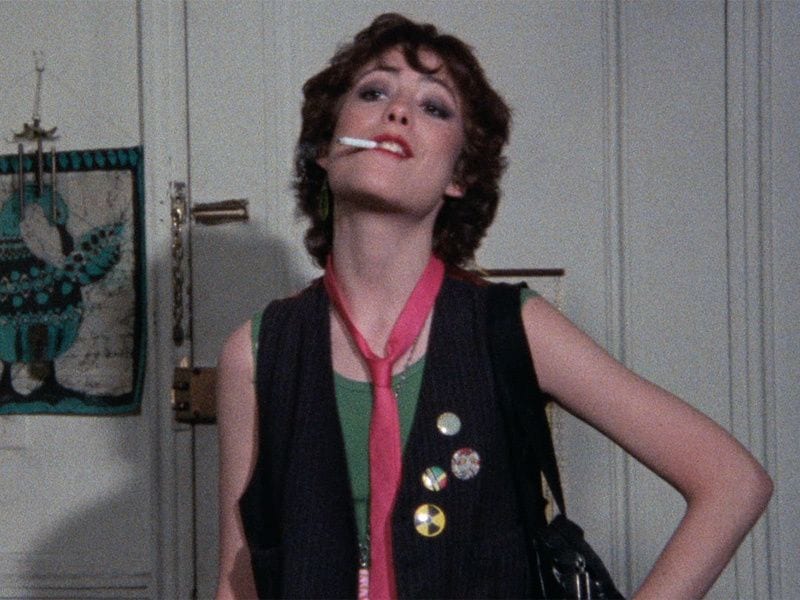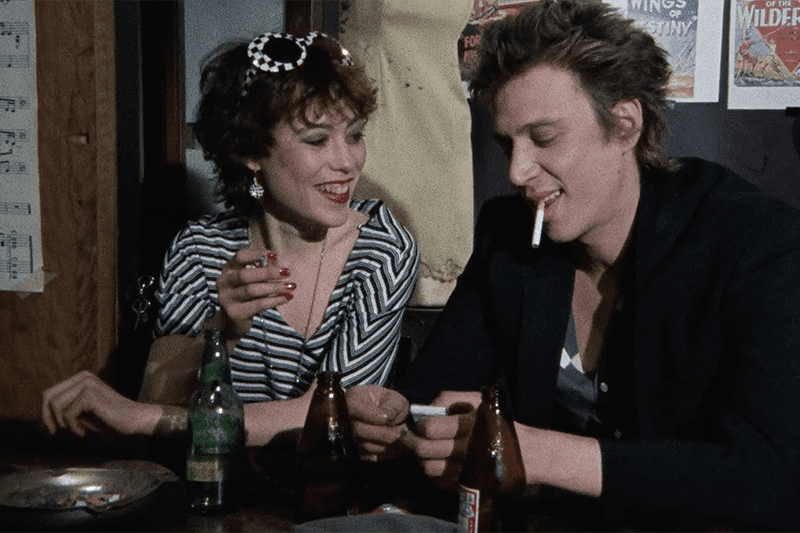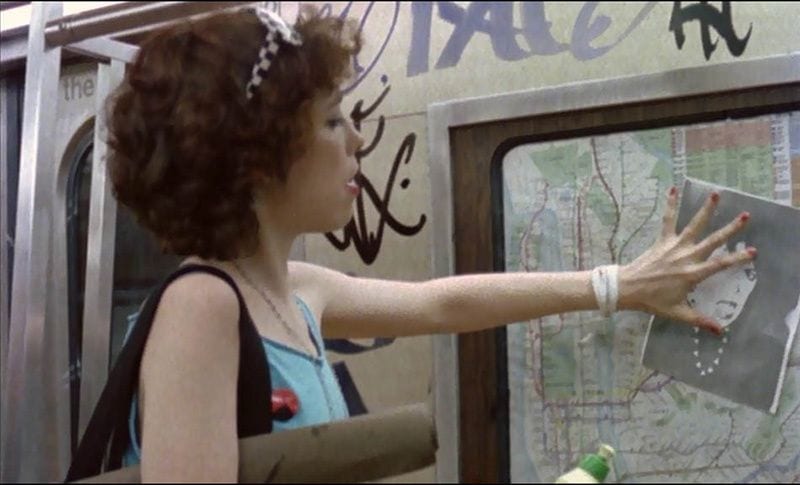
It starts with a theft. These things generally do. But if there’s a justifiable homicide, ought there not be justifiable petty theft? In the logic of early ’80s New York City as manifested in Susan Seidelman’s 1982 debut film, Smithereens, there most certainly is. The film opens with a woman’s hand dangling a pair of outsized sunglasses with a black and white checked pattern, swinging them back and forth like bait on a hook. Another woman enters the frame. We mostly just see her to the level of her waist, wearing a black and white houndstooth skirt. A perfect match. What choice does she have? None, really. So, she swipes the glasses and runs down the stairs into the bowels of the subway and out of the reach of her victim.
Our thief is Wren (Susan Berman), a transplant to NYC from New Jersey. New York City, particularly Manhattan, is that place where no one is from and everyone wants to be—even or especially in the late ’70s/early ’80s when the city was bankrupt, dirty, and dangerous but also exciting, full of opportunity on the cheap, and wide open. President Ford was said to have told the city to “drop dead” in 1975 (well, that’s the story that got around), and the city was facing a prolonged financial crisis under which it threatened to buckle. On the other hand, rents were affordable even to the struggling; unknown artists could manage to live in neighborhoods like SoHo; nightclubs with live music, galleries with unknown painters and photographers and sculptors, theaters with unknown actors performing unheard-of plays by unknown playwrights flourished. Back then you could make a buck without having to make a killing. You could do something, something that felt like something, and still survive. But, of course, you had to do it and someone had to recognize that you were doing it and that was precisely the problem. It is the problem, as always and everywhere, of belonging.
Unlike anywhere else I’ve ever lived, New York breeds a strange insecurity about belonging. I grew up in a Baltimore suburb and no one I knew counted the years to decide when they could consider themselves a “real Baltimorean”. It just didn’t happen. In New York this is a common theme among transplants—and everyone is a transplant. New York is the city of affinity over nascence; we feel we belong and that makes us insecure—because how can we know unless we are recognized as someone who is supposed to be there? And if everyone is a transplant, who has the authority to bestow such recognition, to designate another as belonging?
People are drawn to New York not because of what it actually offers in practice but because of what it purports to offer. Something is always happening and therefore very little is of any significance but it feels significant. Everything feels that way in the city. Every evening is perched precariously on the brink of damnation so you drink deeply of your watered-down debauchery only to awaken to the same noises of the same street urchins on the morrow. The experiences you have in NYC are not the best experiences to be had, the sex you have is not the best sex, the friends you make are not the best of all possible friends—but they ought to be. Yet this is not some Baudrillardian realm of the hyperreal. In fact, that is what is so disappointing for people like Wren. If anything, NYC is the realm of the hyperreal—its experiences fail to rise to the level of the real, they are always clawing their way toward an ever-elusive surface where they might register as meaningful, where they might be recognized, where they might be seen.
Being seen is Wren’s unspoken mantra. Everything she does is a means of angling toward recognition. Whose recognition? It doesn’t matter. Recognition for what? Still to be determined. For Wren, recognition ought to come first, its justification can follow in due course. Shortly after the theft, Wren finds herself inside a subway car, posting xeroxed photographs of herself with her mouth agape on the inner walls of the train while another transplant, Paul (Brad Rinn), watches—fascinated by this avatar of determination in fishnet stockings who reapplies her lipstick with the container she wears like a necklace while chawing at her gum. Wren dresses younger than her age and yet exudes the wry detachment of the ages, a shopworn Lolita looking out over eternity.
As Paul soon discovers, Wren has an angle for nearly everything. The reproductions of the photographs she spreads throughout the city are ripped off from her job at the copy shop and, obviously, the newest edition of the flyer features Wren in her pilfered shades with the caption “Who Is This?”. Wren habitually cuts the line at the Peppermint Lounge, yelling out to the doorman that she is “on the list” but fleeing the scene before the fellow can ask any questions or verify her claim. Wren is adept at scoring free food and drinks, and exploiting friends for petty desires and impulses. When she wants to stay with you, she just shows up and then pouts and stalls when you tell her you can’t accommodate her. While on a date with Paul, Wren blithely makes a move on a musician, Eric (played with the appropriate amount of innate sleaze by punk legend Richard Hell), who gained some local prominence with his band Smithereens and their album of a few years ago and now hopes to make a trip to LA for another recording and a renewed attempt at fame.
This is Wren’s fantasy made manifest: the lure of notoriety without effort, without talent. She tells tall tales (for instance, claiming to have set a man’s New York Times on fire on a bus), regales anyone who’ll listen with her insistence that she should join a band (despite the fact that she plays no instrument and never evinces any ability to sing), and seems convinced that she has her own personal Warhol Factory in operation—with herself as manager, agent, muse, model, flunky, and (sadly) audience. Eric appears to the be the male answer to Wren’s insatiable and indiscriminate longing for recognition. Despite his past accomplishment, Eric subscribes to an “if only” philosophy of life—if only I had this connection, I could make it to L.A.; if only I had sufficient money, I could get a new recording made—and is more than willing to manipulate and cajole women in order to maintain the “if only” structure of his self-involvement.
This is an important aspect of both Eric’s and Wren’s characters. They are both long on desire and relatively short on desired objects, bereft of concrete goals. Eric seems as though he has them. He pays a lot of lip service to the idea of recording a new album but he shows little in the way of effort toward that goal. We never see him with a guitar in his hand, never see him in the company of other musicians. Even the woman with whom he has a business meeting seems more like a romantic conquest than an industry contact; she winds up in a hair-pulling fight with Wren, much to Eric’s mild surprise and enjoyment.
Wren is a bit more open in her aimlessness. She wants fame for its own sake, not as a consequence of the pursuit of some other desire. Seidelman’s New York is an economy of anonymity where the only currency worth having is recognition. Let me be seen but not known—for what is there to know? One gets the sense that there is an epistemic nullity that resides at the center of Eric and Wren. Wren’s photocopied avatars are the perfect metaphor for her condition: flat, endlessly reproducible, an ingratiating low-grade advertisement for nothing but itself, an advertisement that is its only commodity, selling nothing so much as the need to need, the desire to want, the lust for longing.
The gulf between desire and knowledge is precisely what haunts Paul’s feelings for Wren. Paul is the anti-Eric in many ways. He seems congenitally incapable of any real manipulation and is entirely and hopelessly susceptible to the manipulations of others. Paul is an artist for hire, a portraitist, but he doesn’t invest himself in the mystique of art. Instead of bragging about his artistic prowess (and from the dialogue, it appears that Paul is actually making some money at his craft, unlike Eric), he openly confesses that he doesn’t enjoy it and doesn’t think of his efforts as rising to the level of art. It’s a way to get by and not much more.
Paul lives in a van parked near the West End Highway and seemingly right in the thick of a prostitution ring. The pimp insists that Paul will sell his graffitied van to him, the prostitutes continually attempt to get some trade out of him. In one of the most memorable scenes in the film, one prostitute (beguilingly portrayed by Katherine Riley—who sadly died the year of the film’s production at the age of 26) sidles her way into the passenger seat of his van, offering her services. He declines, embarrassed and polite. She runs down the list of things they might do together in decreasing order of expense. Then she asks if she can just sit there a bit and eat her chicken salad sandwich (made by her mother during an earlier visit) to get out of the cold.
Her eyelids are barely raised, her voice bumbles along in a permanent vocal fry; she sounds disoriented, perhaps drugged, chewing her gum even as she consumes an egg. She and Paul immediately fall into the easy patterns of small talk. She asks about his vocation, he inquires after the difficulties involved in having to work outside at night. She worries over her mother’s increasing senility, muses over her penchant for creating clay turtles in art class in high school. She makes a sales pitch one last time, offering to show him a scar she has for five dollars (“it’s in a real interesting place”), and then heads back out into the cold. Her parting question (“how come someone so cute as you is sitting her all by hisself?”) resonates with Paul.
He wants to sit with Wren, to have this kind of desultory conversation with her. But the object of his longing, the recipient of his misplaced desire, is impenetrable to him—he cannot understand her. This woman, selling her body as a set of services, is more knowable than Wren and in a film full of people talking past each other, monologues delivered in the presence of another without any semblance of actual communication taking place, this conversation between Paul and the prostitute is one of the very few moments when the circuit is completed, when conversation serves to bring together (however briefly, however inconsequentially) two people in search of a simple feeling of humanity. This can’t happen with Wren; she is simply inaccessible even to herself.
The conversation is followed by what appears at first to be a throwaway scene. Wren and a coworker are standing in the print shop. Copies shoot automatically out of a machine and are sorted. The camera pans toward the right, past the machine. We first see the coworker reading Cosmopolitan, then Wren reading a magazine entitled Those Who Died Young, featuring Marilyn Monroe, Jimi Hendrix, and James Dean on the cover. The camera then zooms in on a small television near Wren playing a program concerning natural and manmade disasters and their human victims. The narrator intones “There is only one thing for sure and that is that you could be next,” as a passenger jet bursts into flames on the runway. Notice the slippage from a glamor magazine to an exposé on celebrity deaths to a narration on the heightened probability of catastrophe. The sequence nicely articulates Wren’s trajectory: obsessed with image over substance, she longs to be recognized and to be celebrated. The television program and the magazine concerned with celebrity death reinforce the fickle nature of happenstance. Wren depends on some kind of fluke to achieve fame (she certainly makes no real effort toward it). But chance just as easily brings disaster as renown.
Wren herself seems to have some sense of this. She tells Paul of a dream she had: “the whole world had been blown up five years ago, right to smithereens, and everyone was floating around on parts of it. They hadn’t even realized what happened yet.” As dreams in film go, this is not the most impressive one, but the simplicity of her imagined disaster is revealing. First, her choice of the word “smithereens” connects her sense of impending doom to Eric—who projects betrayal with every sneer—and his band. Second, in this dystopia, people merely “float” and make no effort. Third, they lack knowledge of their own condition. Wren then asks Paul: “Am I really awful or something?” Paul can’t really respond: “I don’t know, you’re just… I don’t know.” And he’s right: she isn’t awful and he doesn’t know, indeed, cannot know her. Even when she kisses him in an effort to prove that she’s missed him, all he can do is remain quizzical, repeatedly saying “really?”Wren isn’t awful, she’s empty. To be awful, she would have to have some malign intent. She doesn’t. She’s just selfish and without grounding—moral or otherwise. She desires but she hardly wills. She seems incapable of action without prodding and guidance. She longs to occupy a realm of images, without consequence. Seidelman’s New York is ingratiating in its decay, a realm where people float without purpose and without knowledge. It feels like a place where you can only visit, even while you long to live there.
*
Criterion Collection has recently released a Blu-Ray edition of Susan Seidelman’s debut film Smithereens. The restoration is gorgeous; Seidelman’s sense of color is a prime mover of her approach to narrative and the colors really come alive in the Criterion restoration. The edition includes a 2004 commentary by the director, new interviews with Seidelman and Berman, and two short films that Seidelman made prior to Smithereens.





